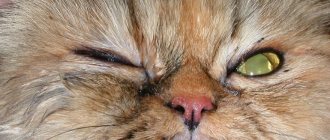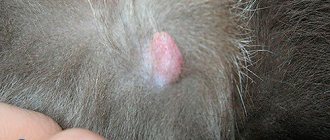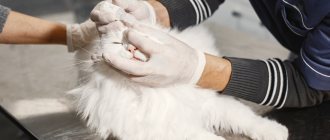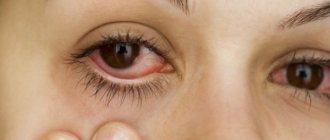A cat's health can be judged with confidence by its appearance. The organs of vision are the first to react to its deterioration. The eyes of a healthy cat are bright, clean, without traces of discharge in the corners. And if their condition is far from ideal, we can assume that the animal is sick.
Red eye syndrome in cats is a very common symptom. It often indicates ophthalmological problems, and sometimes indicates a somatic disease. Reddened protein in most cases is accompanied by itching, burning, lacrimation, photophobia, hemorrhages in the iris, and blepharospasm. Red, inflamed eyes indicate that blood circulation in their choroid is impaired, the blood vessels are dilated, and the surrounding tissues are inflamed. From this article you will learn what causes eye redness and what to do to help your cat.
Causes of the disease
Blepharitis refers to inflammation of the edges of the eyelids. There are several types of the disease. The most common are simple (scaly), ulcerative, and meibomian.
There can be many reasons that cause blepharitis in cats:
- Viruses and bacteria, most often pyogenic cocci.
- Helminthic infestations.
- Subcutaneous mites. In this case, in addition to the eyelids, the neck and face of the animal are affected.
- Pathogens (fungi) of trichosporia and microsporia.
- Allergic reaction of the body to food, pollen, etc.
- Eye injuries received during a fight or as a result of self-scratching.
- Seborrhea. When the functions of the sebaceous glands are disrupted, dandruff and scales appear on the eyelids.
- Autoimmune and endocrine pathologies.
- Violation of hygiene standards.
And this is not a complete list of factors that provoke such an unpleasant eye disease as blepharitis.
Third eyelid prolapse
The third eyelid is the conjunctival fold located in the inner corner of the eye. It performs a protective function and is not normally visible. Causes of third eyelid prolapse:
- decreased muscle tone of the eyeball;
- disruption of the innervation of the smooth muscles of the eyelid in neurological diseases;
- lacrimal gland prolapse;
- inflammation;
- deepening of the eyeball into the orbit;
- microphthalmos;
- tumors and cysts of the third eyelid.
Third eyelid prolapse
Symptoms:
- the presence of a mucous bulge in the inner corner;
- lacrimation;
- photophobia;
- restless behavior.
Treatment is carried out after a comprehensive ophthalmological examination. It consists of eliminating the cause that caused the problem, as well as symptomatic therapy. In some cases it is necessary to resort to surgery.
Main symptoms
Signs of blepharitis vary depending on the form of the disease, but there are also common symptoms - swelling and redness of the eyelids, watery eyes, itching. These phenomena cause discomfort to the cat; it constantly scratches its eyes and thereby becomes even more injured.
Scaly blepharitis is characterized by redness and swelling of the eyelids, and thickening of their edges. At the site where eyelashes grow, gray scales form, from which pus begins to ooze over time. As the disease progresses, eyelash loss may occur.
Ulcerative blepharitis is usually a consequence of scaly blepharitis. After the crusts of pus dry out and fall off, ulcers form in their place, through which infection enters the body. After some time, the affected areas heal and the skin tightens.
Thus, the cat develops an inversion or inversion of the eyelid, which does not completely close the eyes. Eyelashes don't grow. In severe cases of the disease, hair loss or thinning may be observed.
The cause of meibomian blepharitis is increased secretion of secretions from the glands. This leads to redness and thickening of the edge of the eyelid, suppuration.
Why do the whites of cats' eyes turn red?
The whites of the eyes become red due to the expansion of the capillary network located on their surface, as well as when blood flows from the vessels into the thickness of the tissues with the development of small or extensive hemorrhages. Causes of redness:
- mechanical trauma (impact, compression, scratch);
- irritation from chemicals (liquid or volatile);
- allergies (allergic conjunctivitis);
- inflammatory processes (uveitis, iritis, iridocyclitis).
Inflammation of the choroid - uveitis
With uveitis, the choroid of the eyeball is affected and redness appears. The causes of uveitis are divided into exogenous (external) and endogenous (internal).
Diagnostics in a veterinary clinic
Diagnosis of the disease includes taking an anamnesis, examining with a slit lamp, studying clinical signs, and the necessary laboratory tests (washes, scrapings, blood tests, biopsy of eyelid tissue). It is important to differentiate blepharitis from other ophthalmological pathologies and to identify the factor that provoked a decrease in immunity.
Allergic reaction
The owner discovered red spots near the cat's eyes. With what it can be connected? One option is allergies. Analyze what could have caused it. Have you changed the food? Did the cat eat something from the table? Have you tried a new cat weed? If the animal owner answered yes to one of these questions, then the following steps will have to be taken:
- Return to the cat’s usual diet.
- Closely monitor the animal so that it does not climb on the tables.
- Remove everything edible from the table.
- Return to the previous variety of cat grass.
As a rule, allergies go away on their own after the pet returns to its comfort zone.
If none of the above happened, and the red spots formed on their own, then it is advisable to go to a veterinary hospital in order to accurately diagnose and remove the cause of the formation of redness in the eyes.
Treatment method and prognosis
Treatment of blepharitis is complex and carried out under the direct supervision of a veterinarian. Therapy is aimed at eliminating the root cause.
When the disease is caused by the activity of microorganisms, a course of immunoglobulins and antibiotic therapy is prescribed; if it is caused by viruses, then antiviral drugs will be required.
If a subcutaneous mite is detected, relief from blepharitis will take many months, since the animal will also have to be treated for sarcoptic mange or demodectic mange. In this case, precautions should be taken - these diseases are classified as zooanthroponoses and are transmitted to humans.
If the disease develops against the background of a fungal infection, then treatment will also be protracted. Trichophytosis goes away in 2 weeks with the help of three-time vaccination and fungicidal ointments, but microsporia is more difficult to cope with. The use of antibiotics in the form of ointments and injections, the introduction of antibacterial emulsions and suspensions will be required.
For blepharitis of allergic origin, it is necessary to make adjustments to the diet, take antihistamines, and eliminate the source of the allergy.
To treat the eyes, special ointments and gels, antibacterial drops (Saphrodex, hydrocortisone, Betnazol) are used.
The drug "Iris" has proven itself well. Dosage - 1-3 drops depending on the weight of the animal.
Immediately before using them, the edges of the eyelids are disinfected with brilliant green and alcohol-ether. Oletethrin, gentamicin, syntomycin (1%) and methyluracil (10%) suspensions are injected into the conjunctival sac.
Scales and crusts must be softened and removed using saline solution and Vaseline ointment.
It is very important that the cat does not rub or scratch its eyes - this will worsen the course of the disease. To prevent her from harming herself further, a protective collar is placed around her neck, which she will have to wear until her recovery.
In case of inversion, eversion, or closure of the eyelids, an operation is performed followed by follow-up treatment.
If therapy is started in a timely manner, the prognosis for blepharitis is favorable.
Painful tearing
Experienced breeders know that if a cat has one eye watering for a long time, this is a sign of a serious pathology:
- Cold. Animals often have watery eyes if they are hypothermic and have contracted the virus. In addition to eye discharge, body temperature rises. The pet refuses food and constantly sleeps.
- Conjunctivitis is an infectious disease caused by pathogenic microflora, for example, staphylococci or chlamydia. As a rule, with such an ophthalmological pathology, the cat is afraid of bright light, hides under the sofa or bed, and has watery eyes in one or both eyes. The veterinarian will determine what to do.
- Worm infestation. Intestinal parasites very often cause excessive tearing in pets. They affect not only the digestive tract, but also settle in the visual organs, causing severe suppuration and inflammation. The owner immediately notices that the cat’s eye is swollen and watery. After antihelminthic therapy, these symptoms disappear.
- Trichiasis is a rare pathology characterized by abnormal eyelash growth in cats. They appear inside the eyelid, irritate the tear ducts, and cause infection. The animal constantly rubs its eyes and squints. The problem can only be solved surgically. Simple rinsing with medicinal or folk remedies does not help in such a situation.
- Entropion of the eyelids is a problem that often appears in Sphynxes and other hairless breeds. It can only be solved surgically. Antibacterial therapy is carried out after the operation. After a few days, the animal’s vision is completely restored, and all unpleasant symptoms disappear.
An allergic reaction often causes swollen eyelids in pets and excessive tear production. It is triggered by various allergens: pollen, household chemicals, cosmetics, especially aerosols, new food with additives, tobacco smoke, poplar fluff or household dust. The pet's eyes become red, frequent sneezing and scabies appear. To save him from suffering, they are treated with antihistamines and, if possible, protect the pet from contact with irritants.
- Chemical or thermal burns of the eyelids and cornea. Pets get such injuries if household chemicals, all kinds of solvents, dyes, and varnishes come into contact with their faces. Before sending to the veterinarian, you need to find out what solution the pet was burned with - alkaline or acidic. If alkali gets into a cat's eyes, at home they are washed with an aqueous solution of boric acid, and if the eyelids are burned by acid, a soda solution is suitable. When you don’t have such products at hand, it’s enough to rinse the face with plain tap water.
- Foreign objects. If your cat's eye is red and watery, it could be a piece of hard food, a splinter of wood, a speck of sand, or sand. They rupture the membranes of the eyelid, cause inflammation, swelling, and activate the production of tear fluid. To remove foreign objects, the pet's eyes are washed with running water and then wiped with an antibiotic solution. If the cornea is seriously damaged, independent actions can only cause harm and cause complete blindness.
- Injuries. Very often, if several mature cats live in a house, clashes and fights occur, as a result of which the pets injure each other’s eyelids with their claws. It often happens that a cat's red eye becomes watery after a walk. He could have been injured by a dry branch on a tree or a stem in the grass.
Important! In any case, if pathological symptoms appear in a pet, a veterinarian examination is necessary. He will examine the cornea and determine the extent of damage to the eye.
If conjunctivitis is suspected, an analysis of the eye fluid will be required to determine the causative agent - fungi, bacteria or viruses. In special cases, an ultrasound of the eyes, tests for the patency of the lacrimal ducts, and ophthalmoscopy are performed.
What to do at home
A caring owner must provide the pet with complete peace and proper living conditions. Under no circumstances should you select medications on your own, since very often blepharitis is confused with conjunctivitis.
The owner, bypassing going to the veterinary clinic, buys the drops himself, washes the animal’s eyes with herbal infusions and strong tea, but for some reason nothing helps. This is not surprising, because they are treating him for one disease, but he needs to fight something completely different. And often such self-medication leads to very unpleasant consequences and complications, including loss of vision.
Traditional medicine methods can be used, but they should not replace drug treatment prescribed by a veterinarian. It is advisable to use various herbal decoctions (chamomile, calendula, St. John's wort, sage), "Fitoelite" phytolotions, and wash your eyes with a decoction of hyssop.
Phytomineral feeding will also not be superfluous. It is also necessary to strengthen the immune system so that the body has the strength to fight the disease.
Prevention of ophthalmic problems in cats
The following measures can help protect your animal from eye diseases:
- good nutrition;
- regular hygienic eye care;
- timely vaccination of kittens and adult pets, deworming;
- periodic examination by a veterinarian.
Cats of brachycephalic breeds are more susceptible to eye diseases: British, Persian, Scottish, exotic. Why is this happening? The reason for this tendency is a shortened skull. Cats of these breeds have a shallow eye socket, which does not protect the eyes well enough from damaging factors. Owners of such cats are advised to take their pets to the veterinarian from time to time.
Lichen
They took the pet to the dacha. Upon returning, the owner saw a red spot above the cat's eye. Stain and stain, did not attach any importance to this. It will go away on its own. And the stain began to grow. More precisely, they will spread across the animal’s face. Moreover, the fur fell out in this place. The owner anointed it with brilliant green but it didn’t help.
And it won’t help, because it’s very similar to lichen. And only competent prescription of medications and diagnosis can help. Ringworm is detected using a Wood's lamp or by taking material from the affected area of skin for further examination.
If the diagnosis is confirmed, the cat will be prescribed antifungal ointments. Treatment can be done at home by lubricating the affected areas. Just remember that lichen is a contagious thing. The pet is protected from other pets. And it is advisable to keep it away from household members.
Ringworm is treated for about 3 weeks. It is processed using disposable medical gloves. Immediately after the procedure, the gloves are disposed of.











